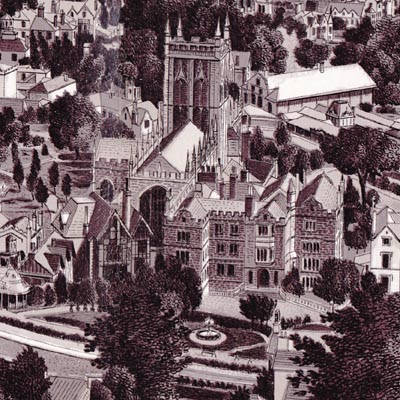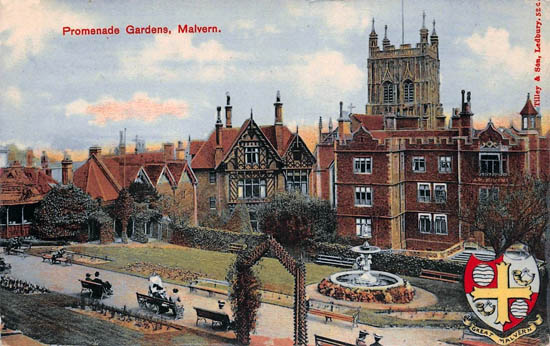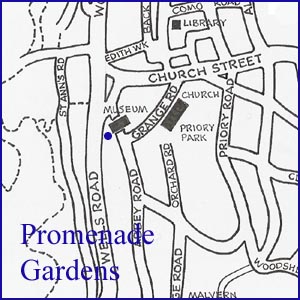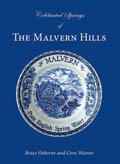
| 
|


Promenade Gardens
NGR 77516 45823
Site Number: C116
By Bruce Osborne and Cora Weaver (C) 2012
Area 1. Malvern Town Centre Springs and Wells
Malvern Hills, England
Description: an ornamental fountain with a substantial tank beneath.
During its long history as a spa town and health resort Malvern had little to offer its visitors or its residents in the way of relaxation or amusement; the vast quantities of Whitson and Easter visitors and the hordes of weekend excursionists had nowhere to go except the hills.
In March 1880 Mrs Elizabeth Wilmot of Rose Bank granted a free lease on a portion of the old Mason estate lying between Rose Bank and Abbey Road, for use as Promenade Gardens "for the benefit of the town and the pleasure and healthful recreation of the visitors",[1] which was ideal for those who could not face a climb up the Hills. A group of interested townsfolk - Messrs.J W & J Burrow, Edward Archer and Thomas Cox (Jnr) - acted as lessees and arranged the layout of the Gardens. The ground was a much steeper incline than today and a vast amount of soil had to be moved from the upper part to make a flat area on the east for walking. In April that year the lessees applied for a fountain in the new Gardens. The town Surveyor reported that the fountain could have 5-6 hours of water daily - approx 1500-1600 gallons per day - depending on availability,[2] but being a scarce commodity it was vital that it should not run to waste. The lessees were obliged to build a 5,000 gallon storage tank so that the water could be used to water the shrubs. A tank was quickly provided and a pipe ran from the tank into Abbey Road for watering the roads.[3]

The gardens were funded by subscription and admission charges, though subscribers to the scheme, which cost 600 pounds, who could use the gardens freely. Visitors paid two shillings (10p) for a dozen tickets which they could buy from the principle hotels and boarding houses. Charging had the dual effect of raising funds and repelling the unruly Black Country excursionists. By November the following year, despite having made a loss, it was decided that the Gardens should be free to visitors "... whose presence in Malvern is of such great importance to its commercial prosperity...".[6] By the turn of the century evening concerts were being held in the gardens; visitors paid 3d for admission and subscribers were given 50 tickets for every half-guinea subscription. (There were 42 threepences in a half-guinea.) By then the Council had installed ornamental incandescent gas lamps, providing free gas. The water for the fountain was also provided free of charge.
With the construction of the Assembly Rooms and attached gardens in 1885 it was felt that the Promenade Gardens would become redundant. However, in 1888 Mr Speer of the Priory bought the Assembly Room Gardens for his own use and the Promenade gardens were needed more than ever.
In April 1900 Mrs. Wilmot, who granted the free lease, died and once again the Gardens' future became uncertain. In June they were auctioned for 2,300 pounds. At the last minute the Council decided not to bid but fortunately the gardens were purchased by Miss Louisa Archer who decided to keep them open for the enjoyment of the public. The traditions of recreation continued into the twentieth century with illuminated concerts that were being held there as recently as July 1913. In the 1920s the Council acquired the Assembly Rooms and Priory Gardens and the Promenade Gardens became redundant. Today the concerts have ceased but the fountain still works and the gardens frequently give pleasure to guests at the Abbey Hotel.
Illustrations:
1. Promenade Gardens and Fountain c.1920s.
2. The Fountain c.2010.
[1] Malvern Advertiser 13 March 1880; 24 Feb 1900.
[2] Malvern Advertiser 1 May 1880.
[3] Malvern Advertiser 15 May 1880.
[4] Malvern Advertiser 24 Feb 1900.
[5] Malvern Advertiser 26 June 1880.
[6] Malvern Advertiser, 12 Nov 1881.

Website: Click Here
SUPPLEMENTARY INFORMATION

Celebrated Springs of
THE MALVERN HILLS
 A definitive work that is the culmination of 20 years researching the springs and wells of the Malvern Hills, published by Phillimore. This is the ideal explorers guide enabling the reader to discover the location and often the astounding and long forgotten history of over 130 celebrated springs and wells sites around the Malvern Hills. The book is hard back with dust cover, large quarto size with lavish illustrations and extended text. Celebrated Springs contains about 200 illustrations and well researched text over a similar number of pages, together with seven area maps to guide the explorer to the locations around the Malvern Hills. It also includes details on the long history of bottling water in the Malvern Hills.
A definitive work that is the culmination of 20 years researching the springs and wells of the Malvern Hills, published by Phillimore. This is the ideal explorers guide enabling the reader to discover the location and often the astounding and long forgotten history of over 130 celebrated springs and wells sites around the Malvern Hills. The book is hard back with dust cover, large quarto size with lavish illustrations and extended text. Celebrated Springs contains about 200 illustrations and well researched text over a similar number of pages, together with seven area maps to guide the explorer to the locations around the Malvern Hills. It also includes details on the long history of bottling water in the Malvern Hills.
Written by Bruce Osborne and Cora Weaver, this book is available on-line for £15.00 (delivered UK) - click Malvern Bookshop on the green panel top left. Alternatively send a cheque payable to Cora Weaver with your name and address to 4 Hall Green, Malvern, Worcs. WR14 3QX.
1) TOPOGRAPHICAL LOCATION:
Malvern Hills - arguably Britain's original National Park
2) LANDSCAPE:
Park or Garden3) INFORMATION CATEGORY:
A Spring, Spout, Fountain or Holy Well Site4) MALVERN SPRING OR WELL SITE DETAILS:
3 SPLASHES - Of Moderate Interest
5) GENERAL VISITOR INFORMATION:
Access On FootNot Open To Public


